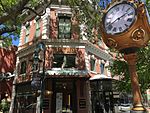Palmetto Building
1913 establishments in South CarolinaBuildings and structures in Richland County, South CarolinaColumbia, South Carolina Registered Historic Place stubsColumbia, South Carolina building and structure stubsHistoric American Buildings Survey in South Carolina ... and 5 more
National Register of Historic Places in Columbia, South CarolinaOffice buildings completed in 1913Office buildings on the National Register of Historic Places in South CarolinaSkyscraper office buildings in South CarolinaSkyscrapers in South Carolina

The Palmetto Building, built during 1912–1913, is an early skyscraper in Columbia, South Carolina. It was designed by architect Julius Harder, and Wilson and Sompayrac served as supervising architects. Upon completion it was the tallest building in South Carolina.The Palmetto Building was listed on the National Register of Historic Places in 1980. Since the mid-2000s, it has housed the Sheraton Columbia Downtown Hotel.It was important in the architectural career of Charles Coker Wilson, establishing his credentials for steel frame skyscraper construction.
Excerpt from the Wikipedia article Palmetto Building (License: CC BY-SA 3.0, Authors, Images).Palmetto Building
Main Street, Columbia Main Street District
Geographical coordinates (GPS) Address Nearby Places Show on map
Geographical coordinates (GPS)
| Latitude | Longitude |
|---|---|
| N 34.003888888889 ° | E -81.034722222222 ° |
Address
Main Street 1401
29201 Columbia, Main Street District
South Carolina, United States
Open on Google Maps









